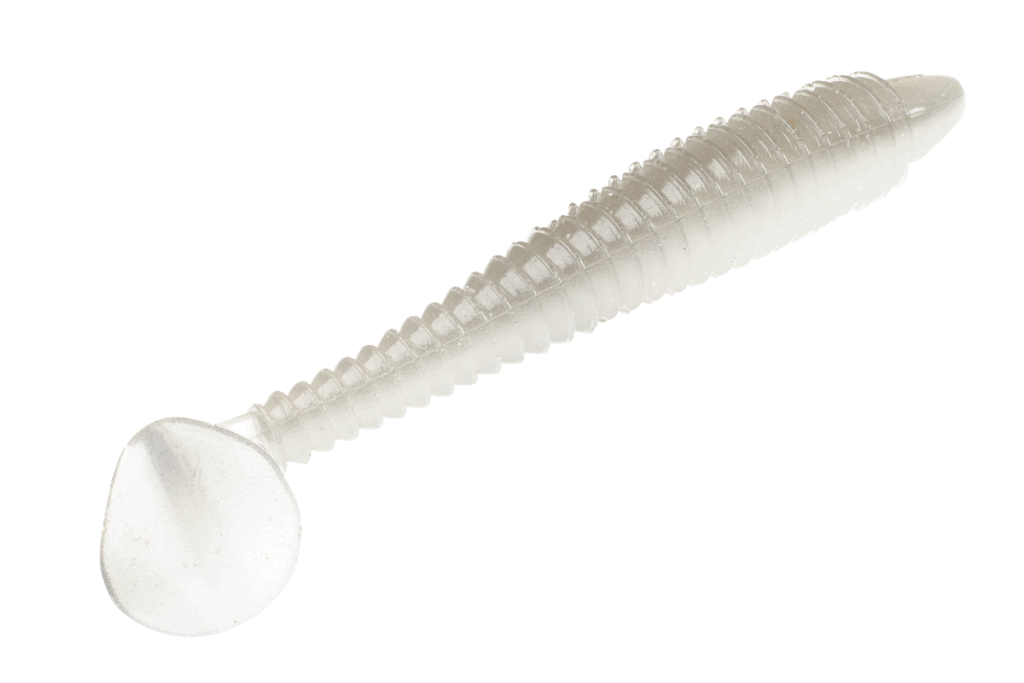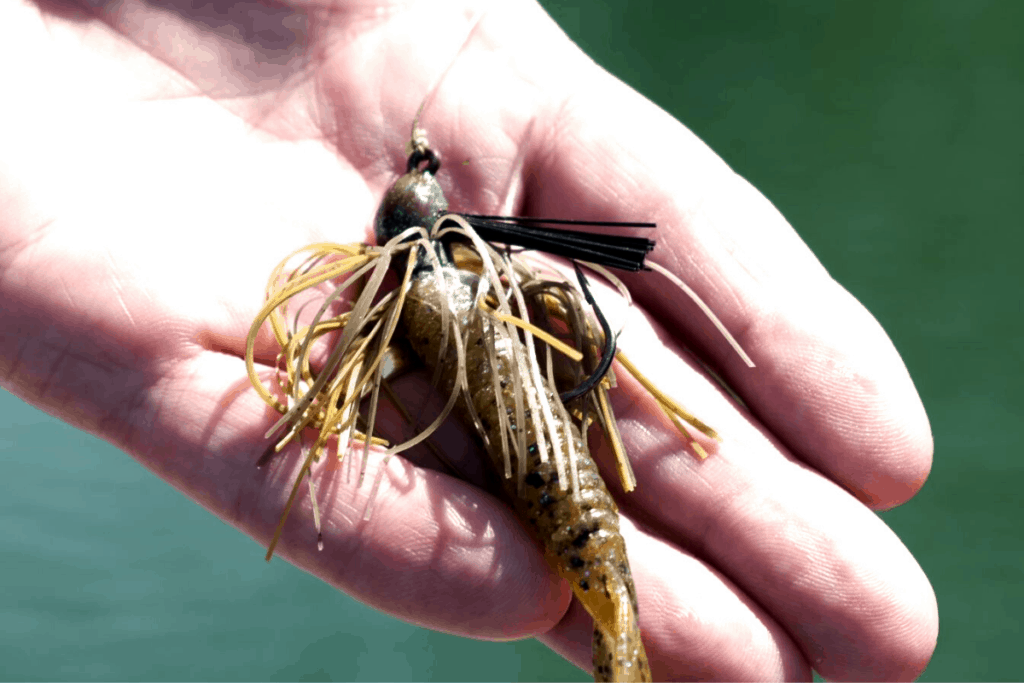Winter can drive bass anglers crazy. Just a month earlier, fish could be found seemingly everywhere. They could be caught on a variety of lures and most importantly, the days were still warm. Then the freezing temps hit and the lake that held life everywhere a short while ago appear devoid of anything that swims.
The three places to start looking for winter bass are: 1) rocks, 2) on the absolute bottom in the center of a major structure area, and 3) up against hard vertical structure or cover.
In this article, we will break down each of these locations, what lures I would use to probe these locations, and what presentations are the best suited to getting sluggish winter bass to bite.
Location #1 for Winter Bass: Rocks
Largemouth and smallmouth love rocks. They especially love rock when the temperatures are cold. If you have ever held your hand against a brick house at night on a cold day the answer becomes obvious.
Rock retains heat. As the sun beats down on this hard form of cover throughout the day, the rocks hold that heat. When the sun goes down, that heat is released back into the surrounding water.
A few degrees difference is all it takes to attract fish to this form of cover.
The depth of the fish on rocky cover will be solely determined by the clarity of the water and current – if it is present.
River systems will keep bass much shallower than their lake and reservoir counterparts. If you can find a nice pile of rocks along shore or even out in open water on a river during the winter, you have almost guaranteed yourself that fish will be there.
On a lake or reservoir, especially one with clear water, fish could be holding on rocks that are sitting in forty feet of water. If you have a good electronic graph with side imaging, it will pay off in this scenario.

Lure and Presentation #1 for Winter Bass
When fishing this type of situation, I personally love to use a small swimbait, or even a single-tail grub. Most of the time I will use white and throw it on spinning gear with 6lb mono. I will switch over to fluoro if the target zone is deeper than twenty feet.
Make a long cast and let the swimbait sink all the way to the bottom. When you feel it hit, pop the rod slightly to get the action going. Keep the retrieve steady, but every so often, let the lure sink back down and maintain bottom contact. It is important to keep the bait as close to the bottom as you can, while still maintaining a swimming action.
If you feel some weight, reel down with a slight side sweep of the rod.

Lure and Presentation #2 for Winter Bass
My second lure and presentation for fishing rocks in the winter time involves a jig and I will drag it.
I start with a simple ½ oz flipping jig with some sort of plastic trailer that represents a craw. Make a long cast past your target and let the jig sink clear to the bottom. At this point, you have a few option. You can side-sweep the rod and let the jig bang across the rock, reel in the slack, then repeat.
Another simple presentation is use the trolling motor, set about as slow as you can run it, and leave the jig drag across the rocks as you use the electric motor to move the boat along.
The third way you can drag a jig, is to allow the wind to push you along. This only works if it is a slight breeze.
No matter which dragging presentation you select, the key is to keep in contact with the bottom and not move to fast. If the jig gets hung up too much, try a lighter one. If you cannot feel the bottom, increase the weight.
Location #2 for Winter Bass: Deep Holes
The second location to find winter bass is on that can be found on any body of water. This key wintering spot for bass is simple – it is the deepest, absolute center location in a cove, channel, or creek arm. Let me explain with a simple example and then we will take it from there and apply it to other waters.
Imagine you are fishing a farm pond. Those bass will pull off the shoreline in the winter and sit on the bottom of the deepest portion of that pond. Find that spot and you have found a whole lot of winter bass.
Where Winter Bass Hide on Small Rivers
The simplest waterways to apply this to are small rivers. Many small rivers are quite shallow. The bass will pull out of those shallow locations and winter over in “holes.” When the shallows dump into deeper water you will find a typical wintering location.
Winter Bass Fishing on Lakes and Reservoirs
On large bodies of water, like lakes and reservoirs, I tend to focus on large coves, bays, or creek arms. I will then start in the absolute center of those locations.
Lure and Presentation
For this second location type, I almost always drag a jig or use a swim bait, just like in the above-mentioned section. But, I will also use a third type of lure and presentation in these deep-center-of-the-lake areas.
A Ned Rig is dynamite for this location and the presentation is ultra simple. Toss the Ned Rig out, let it sink, and then let it sit. There is no need to impart any action. I only use this third lure and presentation when I feel I have located some fish with the other two. Fishing a Ned Rig this way (deadsticking) can be quite boring and you do not cover a lot of water. That is why it is imperative to have found some fish first, but it will catch numbers.
The Equipment
For the Ned rig, I will use a medium heavy spinning rod with line in the 6 – 8lb range. Either mono or fluoro work well. If I am going to drag a flipping jig, my rod of choice is medium heavy with a fast tip. The length of both rods will be around the 7ft mark.
For my jig rod, I prefer to use a slow gear ratio baitcaster, something in the 5.2:1 range. Normally, I have high speed reels on my jig rods, but with this method, the slower the better.
A quality rod is also important. You will feel many more bites and what the actual bottom contact is with a sensitive rod. Remember, a quality rod means getting the lightest material possible, yet still maintaining strength. A $20 rod is not going to work as well as one that breaks the $100 mark.
The Presentation for Winter Bass on Lakes
Method 1
You can let the wind push you along. Make a long cast and let the lure sink to the bottom. Do not reel it in. Just let the wind keep you going. Make sure that you feel the bottom the entire time. If you cannot maintain bottom contact, either add a heavier weight, or you will need to try an alternate method of lure movement, because the wind may be too strong. Pop the rod every so often to clear debris from the lure and let it settle back to the bottom. Remember, feeling the bottom is key to success.
Method 2
You can impart your own action on the lure. Use a slow side sweep of the rod, reel up the slack, and repeat. The danger in this second style is that we tend to fish the lure way too fast, but this is why I mentioned using a slower gear ratio reel. Our summertime habits come back and we may fish like this for hours and not even notice that we are wasting our time.
Method 3
The last method is my favorite. Set your trolling motor anywhere from 10-20%. Cast the lure out, let it sink, and then just let the trolling motor do all the work. This method is so effective because it eliminates all possibility of us moving the bait too quickly. Using this method of delivery is also the easiest for the angler to focus on what is happening on the end of the line. Day-in-and-day-out, this third method is what I prefer to use because it works so well.
The Bite and Hookset
It is not a surprise that during the winter, bass are sluggish and the bite is almost imperceptible. Most of the time, you will just notice some slight tension, or additional weight on the line.
If you are using the draggin’ method properly, there will be no slack in your line at all. This means the hookset is immediate, so if there is something that feels strange or spongey, set the hook.
This time of year you want to avoid the hard, lip ripping hooksets that are so fun in the spring and summer. Just use a side sweep method and apply steady pressure to the lure. Reel down tight and keep tension. If your hooks are sharp, you will catch the bass because their was no slack line in the presentation and all of your energy was transferred directly to the hook itself.
Final Thoughts
Once you fall in love with the draggin’ method, you will quickly apply it to other situations throughout the year. Co-anglers in bass tournaments, who have been relegated to the back deck of the boat, have used this method very effectively for decades.
It is not the most exciting method to use, or the fastest, but it is one of the most effective. Why? Because the lure is in the zone 99% of the time. This method eliminates a lot of the casting, sinking, and winding that other retrieves require.
If you notice that your lure is constantly getting covered in debris, use your rod to give it a good pop every so often. This will do two things for you: 1) it will clear the junk from your lure, and 2) it might just elicit a reaction strike from a bass that was following it along.
Good luck this winter with the draggin’ presentation. I promise you, it will work. Keep good contact with the bottom and pay attention to the end of that line.

